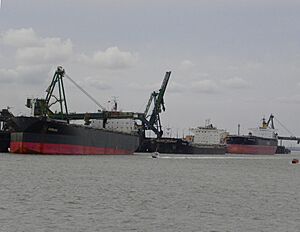Port of Gladstone facts for kids
The Port of Gladstone is a very important seaport located in Gladstone, Queensland, Australia. It's one of the busiest ports in the world. This port is especially known for shipping out huge amounts of coal. In fact, it's the fourth largest coal exporting seaport globally.
Contents
What is the Port of Gladstone?
The Port of Gladstone is a large area where ships come and go. It helps move many different products from Australia to other countries. This port is vital for Queensland's economy. It connects local industries to the rest of the world.
How the Port Works
A port like Gladstone is like a giant loading and unloading station for ships. It has special areas called wharves or terminals. Each area is designed to handle different types of goods. For example, some parts handle coal, while others might handle aluminum or other materials.
Key Activities at the Port
- Exporting Coal: A huge amount of coal from Queensland mines is shipped out from Gladstone. This coal is used for energy and making steel in many countries.
- Shipping Other Goods: Besides coal, the port also handles other important products. These can include things like aluminum and grain.
- Supporting Industries: The port helps local factories and businesses send their products to customers worldwide. It also brings in goods that Queensland needs.
History and Growth of the Port
The Port of Gladstone has grown a lot over many years. It started small and became a major international port. Each part of the port has its own story of development.
Early Beginnings at Auckland Point
The port's history of exporting coal began at a place called Auckland Point. This started way back in 1925. Later, in the mid-1930s, live horses were also moved through this part of the port.
Barney Point's Role in Coal Export
Barney Point is another important area. It was used to export coal that came from Moura. Barney Point officially became part of the Port of Gladstone in November 1998. This helped the port handle even more coal.
Fisherman's Landing and Future Plans
The Fisherman’s Landing section of the port opened in 1980. It was made bigger in the 1990s to handle more ships and goods. There are plans to expand it even further in the future. This shows how important the port is for growth.
Boyne Wharf and Aluminum
Boyne Wharf is a special part of the port. It was opened in August 1982. This wharf is mainly used by the Boyne Island aluminium smelter. An aluminum smelter is a factory that makes aluminum metal.
South Trees and Queensland Alumina
The South Trees area of the port is used by Queensland Alumina Limited. This company makes aluminum products. The port helps them ship their goods around the world.
RG Tanna Coal Terminal
The RG Tanna Coal Terminal is a very modern part of the port. It opened in 1997. This terminal is specifically designed to export coking coal. Coking coal is a special type of coal used to make steel. Much of this coal goes to steel mills in Japan.


